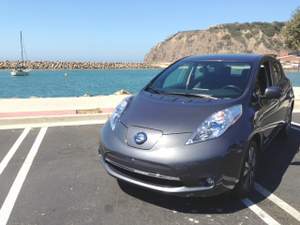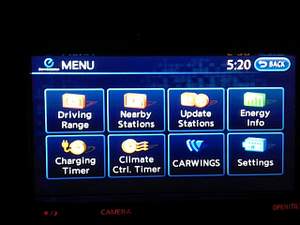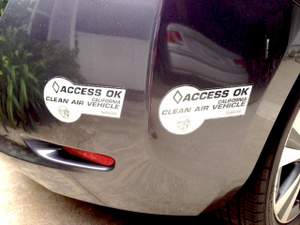
This EV is not for everyone, but it’s a great car for more folks than you would think
Nissan may be the most honest car company out there today because you will actually hear them say that the 2013 Leaf may not be the right car for you. What is this, a Miracle on 34th Street Gimbles and Macy’s lovefest?
So if the Leaf isn’t for everyone, who is it for and are you one of those that should own one? This is where the fun begins because if your lifestyle and driving pattern falls within the Leaf’s sweet spot, then the answer is a resounding–YES!
If you are not familiar with plug-in technology let’s lay down some basics:
• There is no engine so there are no tune-ups, filters and belts to change, oil to check or add, etc.
• There is single-speed transmission so there are no fluids or filters to service
• You will never, ever buy any type of petroleum product to make the Leaf go down the street
That last one is a doozy and should get your attention, especially if you are currently spending $300 – $500 monthly on gasoline for your work commute and around town driving. So with all this great news, what do you need to know since Nissan has already said the Leaf may not be right for you?
The single biggest consideration is how far you drive daily and, secondly, if you can you recharge the battery at your destination. It doesn’t sound like much, but these factors are no small thing when owning a plug-in car. Your days of leaving the house with a 1/4 tank of gas knowing you can stop and fill the tank at hundreds of stations in mere minutes are over. If you run out of electricity in the Leaf you will need to find a charging station and wait until the car has sufficient battery charge to get you to your destination (or back home). Is this enough to scare you away from considering owning a Leaf? Let’s talk about the car and what to consider before pushing the start button, then we will come back to whether a Leaf should be in your garage.
The 2013 Leaf is the second generation model; the first was introduced in the USA in December 2010. It has a 24kWh Lithium-Ion battery (Li-ion for short) powering an 80 kW AC Synchronous motor with 107 horsepower. Charging the Li-ion battery is accomplished through a regenerative braking system and two plug-in ports offering three charging speeds:

• Trickle 110V 21 hours: Discharged to a full charge
• Normal 220V 4 – 7 hours: Discharged to a full charge
• Quick 480V 30 minutes: Discharged to an 80% charge
The regenerative braking system converts braking or coasting into electricity, which is stored in the battery. You will come to enjoy monitoring the battery charge and mileage range (metered almost instantly with dashboard gauges) when driving around town or coasting down hills. It is quite common to start an in-town journey, of stop-and-go driving, to return with more or only a few miles depleted from the beginning range. However, where the regenerative braking system does not offer any help in charging the battery or adding to the driving range is when on the freeway. Cruising along at 55 – 65mph over an extended period will result in the battery charge and driving range decreasing right before your eyes. And if you decide to drive like everyone else on the freeways (at least in SoCal where I live) then you will be driving 75 – 85mph, which has a decidedly negative effect on your battery charge and driving range.
So how do you drive a Leaf? The first goal is to keep it fully charged before taking any trip of length. Then, before even getting into the car, you must calculate the distance you will be driving before you would have the ability and time to plug-in again. It could go something like this…
You leave for work in the morning, commuting one way 45 miles, with 95 miles driving range. When at work you can plug-in at the trickle charge or 110V level for eight hours. You will get approximately 45 miles over this period put back into the driving range which means your return home commute is completely covered. This scenario does not account for any stop-and-go traffic which could result in driving miles being added through the regenerative braking system; if you hit enough slow traffic, you will have used very few miles of the original 95 you started with.
If this sounds close to your five-day-a-week routine, then you could replace your current car and never, ever have to stop at a gas station again. And since your weekend miles are most likely fewer than your daily commute, the Leaf would deliver miles and miles with no out of pocket (gasoline) fuel expense. But what to do when you need to drive someplace further than the Leaf can accommodate?
1) Suddenly, the Leaf becomes your “second” car
2) Rent a car
3) You sign-up for Nissan’s One-To-One Rewards Program where your dealer may provide a set number of days in a conventionally powered Nissan car. Note: Not all Nissan dealers participate in this program and each have different loaner car policies. Shopping between dealers to see which one in your area offers the most desirable One-To-One Rewards Program benefits should be part of your Leaf purchase research
One other safety net if you live in California and are a AAA member (check your state’s local AAA club) is that you can get an emergency Quick charge from one of their service trucks. Just like if you ran out of gasoline and AAA dumped a five gallon can in your tank, select AAA trucks are equipped with the 480V generator that will give you about 20 miles driving to get you to a dealer or other charge station. Please, though, do not rely on AAA to get you to your destination – just plan better.
Technical Elements
When taking delivery at the dealership there is a 2+ hour education and introduction process provided by a factory-trained Leaf Specialist. You learn about all the systems, charging, driving and safety aspects of owning an all-electric vehicle. So rather than try and go over everything you would learn in that session, let’s hit some of the basics to give you a feel for the car and it’s technology.
I was driving the fully optioned SL model which came with the three charging options listed above, hard drive-based navigation with voice activation in a 7-inch color LCD display, Bluetooth, Bose Premium 7-speaker audio system with USB, Pandora link and Sirius XM, Homelink and Intelligent Key, which allows for locking/unlocking the front doors with the push of a button on the door handle.
The SL model has all the comfort and safety features you would expect on a nicely optioned car such as front, side and roof-mounted (curtain) Air Bags, anti-theft alarm system with engine immobilizer, heated front (bucket) and rear (bench) leather appointed seats, 6-way adjustable driver’s seat, split-folding rear seatback, heated and tilting steering wheel, power and heated outside mirrors, power door locks and one-touch power windows, rear view camera, fog lights, LED headlights and a Photovoltaic solar panel (for charging the 12V battery) mounted on the roof spoiler.
Nissan also has a technology called Carwings Telematics which allows, from a smart phone, to remotely check your battery charge and estimated driving range, begin and end charging (with a Timer function) and activate the climate control system.
The 2013 Leaf comes with three warranties:
Basic: 3 year/36,000 miles
Battery: 8 year/100,000 miles
Drivetrain: 5 year/60,000 miles
Driving Impressions
The Leaf SL comes with 17-inch 5-spoke aluminum-alloy wheels, all-season tires, MacPherson independent strut front suspension and torsion beams in the rear, with stabilizer bars at both ends, electronic stability and traction control. Combine this with a low center of gravity, because the batteries are under the seats, and this car handles very well. The tight turning radius of 17 feet handles most neighborhood streets without resorting to a three-point turn.
Regenerative braking systems can sometimes be grabby as they are not only stopping the car but converting energy to electricity. The Leaf’s four-wheel antilock disc brakes (with ABS) stopped straight and true.
The Leaf gets-up-and-goes with smooth acceleration and 100 percent torque at any speed through the direct drive transmission. Merging onto SoCal freeways and getting up to 65 mph were not an issue. Once cruising at freeway speeds the Leaf is quiet, more like silent, and smooth with only minor wind noise. The low 0.29 drag coefficient comes from underbody flat panels, a rear roof spoiler and those “bug” headlights that are designed to redirect the airflow away from the car. The result of all this with the lightweight wheels and low-rolling resistance tires delivers a combined city and freeway EPA MPGe (miles per gallon equivalent) of 116: 130 city / 102 highway.
At slow speeds the Leaf emits a whirring sound to alert pedestrians that this completely silent car is nearby. In reverse, a pleasant version of the annoying beeper found on delivery trucks lets people know the Leaf is backing up. Both are very useful as driving an all-electric car includes the responsibility of realizing that no one knows you are there and that you need to protect them.
Interior
Finding a comfortable seating position with the 6-way adjustable driver’s seat and adjustable steering wheel was easy. Headroom in the front is ample, even for the tallest drivers. The front bucket/rear bench seats can accommodate four adults with good head and leg room. The large glass area provided an open, airy feeling with good visibility. The cabin environment is as quiet as the exterior.

Pushing the start button results in a pleasant chime that lets you know the car is ready to be driven. The two level dash layout includes all the gauges necessary to monitor driving range and battery charge levels with the video screen centered for easy reach and viewing. The gear selector is a round knob in the center console that gives you three options – Park, Drive and Reverse – and is operated similar to a joystick. You can also shift into B-Mode where the regenerative braking force and brake response are increased. Nissan has designed a simple-to-understand and use cockpit with all buttons, knobs and switches within easy reach.
Exterior
When you look at the Leaf one thing comes to mind: aerodynamics. This car was built to slip through the wind with the least amount of resistance. Most critical comments center around the headlight design, but just like the Mini dash and the Juke front end, all styling tastes are personal and you will either like the Leaf headlights or not. Otherwise, the car has an identifiable contemporary shape with four doors and rear hatch, with the charging door on the nose.
Pricing
The 2013 Leaf I was driving was the fully optioned SL model with a MSRP of $36,910, which included a $850 Destination Charge. Depending where you live and your taxable income, you could potentially reduce your final cost by as much as $10,000 through Federal and State programs. It is recommended contacting your CPA before considering a Leaf purchase so you are completely clear on the tax credits. Not relying on the dealer to provide this information will serve them and you best.
Leaf pricing before any Federal or State tax programs, but including the destination charge of $850 is:
Model S $29,650
Model SV $32,670
Model SL $35,690
For those in California, the Leaf automatically qualifies for the coveted HOV sticker, which allows driving in the carpool lane solo. If you haven’t heard the stories, people buy the Leaf just for this benefit.
Observations: 2013 Nissan Leaf SL
The Leaf drives and handles as good, or better, than a conventionally powered car and is very, very quiet. Therefore, placing it on your shopping list comes down to how far do you drive and whether this would be your primary vehicle. If you fall into that 90-mile round trip daily (or one way with a charging station) driving range, then the Leaf should be seriously considered.
You will enjoy the smooth ride with tight turning and the instant torque at any speed. The Leaf delivers a comfortable ride experience with peppy acceleration.
What you will fully enjoy and embrace is whizzing by gas stations and not having to pay attention to the odometer for your next oil change or major service appointment.
There is much debate on whether owning an electric or hybrid vehicle makes financial sense, and the payback timeline. Early EV and hybrid owners were trendsetters, but that has all changed. Because of improved range and technological advances, consumers today are buying an EV or hybrid because of their drivability, comfort, performance and of course, their low impact on the environment and the idea of reducing imported fossil fuels. This “Statement Ownership” has been recognized and encouraged by the government through tax breaks on electric vehicles and home fast charging systems.
So, where do you fit in as a future EV owner? If the majority of your driving is the in-town or short freeway jaunts and you have access to a conventionally powered car, then you are the perfect candidate to purchase an EV. Make sure to take a lengthy test drive, which replicates your longest and most common trip, as this is the only way to truly see if the Nissan Leaf is right for your lifestyle.
And of course…Happy Driving!

For related stories, check out:
Electric Car Deals May Threaten Segments Future
California Helps Drivers Plug-in and Replace Clunkers
How To Find the Best Price For an Electric Car

14 thoughts on “Road Test: 2013 Nissan Leaf”